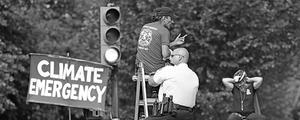PRINCETON, NJ -- Well under half of Americans (34%) think that temperatures in their local area have been warmer than usual this winter -- compared with 79% who reported warmer temperatures last year. The rest say temperatures have been the same (45%) or colder than usual (19%). The majority of those who perceive warmer temperatures say the change is due to global warming, while last year the majority said it reflected normal variations.
![Next, I’d like you to think about the weather in your local area this winter season compared to past winters. Have temperatures in your local area been -- [ROTATED: colder than usual this winter, about the same, (or) warmer than usual this winter]? (If warmer, ask) Do you think temperatures are warmer mainly due to -- [ROTATED: global warming (or to) normal year-to-year variation in temperatures]?](https://content.gallup.com/origin/gallupinc/GallupSpaces/Production/Cms/POLL/ez9ycz-r4ek2bfnzcugr0a.gif)
These results, from Gallup's annual Environment survey conducted March 7-10, highlight how different this winter is from last winter -- at least as perceived through the eyes of the average American.
Data from the National Climatic Data Center of the National Oceanic and Atmospheric Administration show that, while December of this winter was slightly warmer than December 2011, January's and February's average national temperatures this year were significantly colder than in 2012 (31.90 degrees in January of this year compared with 36.20 last January, and 34.78 in February this year compared with 37.74 last February). Thus, the shift in Americans' perceptions appears to reflect real-world change.
This year, the slight majority of those who perceived warmer temperatures attributed them to global warming -- 20% of the overall sample thought that local temperatures were warmer and attributed it to global warming, while 13% thought they were warmer but due to normal fluctuations. Last year, those who perceived warmer temperatures were much more likely to attribute the change to normal variations. Thirty percent of the overall sample in 2012 said temperatures were warmer due to global warming, while 46% said they were warmer due to normal fluctuations.
Residents in the West remain the least likely to perceive warmer-than-usual winter temperatures, as they were last year. Those living in the other three regions of the U.S. are all about equally likely to perceive warmer-than-usual temperatures; last year, those in the South were somewhat less likely than those in the East and Midwest to say their local temperatures were warmer. Still, despite these differences, residents in all regions became far less likely to perceive warmer temperatures this year.

Implications
Americans' perceptions of disturbances in their local weather can be important for many reasons, not the least of which is the reality that these views can affect attitudes toward a significant policy issue -- what to do about climate change.
Although climate change can have many manifestations according to experts -- including increases in the probability of severe weather and storms -- one of the most discussed correlates of climate change is global warming. And, increased warming appeared to be a reality to Americans last March, when almost eight in 10 perceived that temperatures in their local area were warmer than usual.
This year presents a different picture. Fewer than half as many Americans perceive that their local temperatures are warmer -- apparently reflecting the fact that temperatures across the nation have in fact been colder in January and February of this year. On a proportional basis, more of those perceiving warmer temperatures feel the change was due to global warming, which marks a change from 2012 -- but overall, the "warmer temperatures due to global warming" group is much smaller this year than it was last year because so many fewer Americans think that temperatures are warmer.
Gallup's annual environmental poll included a number of other measures of the public's views on climate change and global warming, and these will be reported on Gallup.com in the days ahead.
Survey Methods
Results for this Gallup poll are based on telephone interviews conducted March 7-10, 2013, with a random sample of 1,022 adults, aged 18 and older, living in all 50 U.S. states and the District of Columbia.
For results based on the total sample of national adults, one can say with 95% confidence that the margin of sampling error is ±4 percentage points.
Interviews are conducted with respondents on landline telephones and cellular phones, with interviews conducted in Spanish for respondents who are primarily Spanish-speaking. Each sample of national adults includes a minimum quota of 50% cellphone respondents and 50% landline respondents, with additional minimum quotas by region. Landline telephone numbers are chosen at random among listed telephone numbers. Cellphones numbers are selected using random digit dial methods. Landline respondents are chosen at random within each household on the basis of which member had the most recent birthday.
Samples are weighted to correct for unequal selection probability, nonresponse, and double coverage of landline and cell users in the two sampling frames. They are also weighted to match the national demographics of gender, age, race, Hispanic ethnicity, education, region, population density, and phone status (cellphone only/landline only/both, cellphone mostly, and having an unlisted landline number). Demographic weighting targets are based on the March 2012 Current Population Survey figures for the aged 18 and older U.S. population. Phone status targets are based on the July-December 2011 National Health Interview Survey. Population density targets are based on the 2010 census. All reported margins of sampling error include the computed design effects for weighting.
In addition to sampling error, question wording and practical difficulties in conducting surveys can introduce error or bias into the findings of public opinion polls.
View methodology, full question results, and trend data.
For more details on Gallup's polling methodology, visit www.gallup.com.
